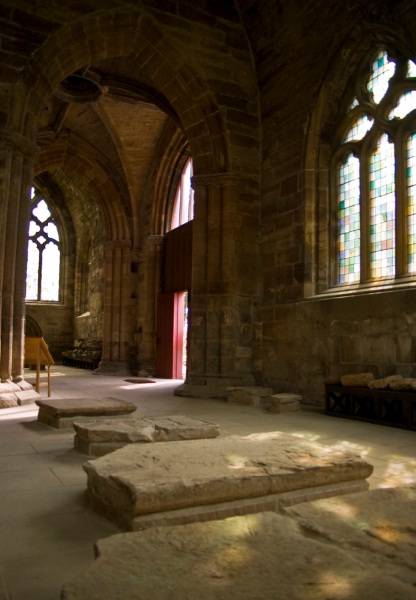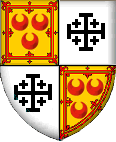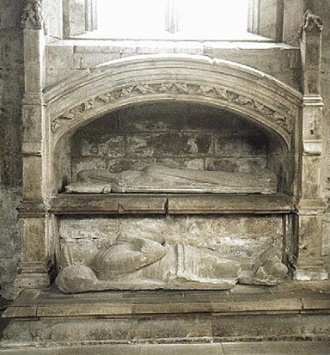|
 By the early middle-ages, Jerusalem had become a
major place of pilgrimage, although the difficulties that would be
encountered by travelers passing through lands constantly in
turmoil, divided by wars and quarreling princes, coupled with a
long trip by sail across seas devastated by pirates and marauders,
made the venture extremely risky. By the early middle-ages, Jerusalem had become a
major place of pilgrimage, although the difficulties that would be
encountered by travelers passing through lands constantly in
turmoil, divided by wars and quarreling princes, coupled with a
long trip by sail across seas devastated by pirates and marauders,
made the venture extremely risky.
On reaching the Holy Land there were few Christian
organizations able to provide assistance to travelers, who were
harassed and sometimes captured and held for ransom by the local
inhabitants. The original Order of Saint John, surviving today as
the Sovereign Military Hospitaller Order of Saint John of
Jerusalem, of Rhodes and of Malta (the Sovereign Military Order of
Malta), could be traced back to a hospital probably founded in
about 1080 by the brothers of the Benedictine Monastery of Saint
Mary Latina.
This Order may be regarded as the first of the
Chivalric Orders of Knighthood that were imitated across Europe,
both as Religious Military foundations, and later as Princely
awards for their allies and supporters, and it is to this
beginning that we identify the Knights Templar, and with the
beginnings of the Banking system.
The largest, and most powerful of the Christian
military orders, the Poor Knights
of Christ and the
Temple of Solomon, originally
named The Poor Knights of Christ and the Temple, which is in
Jerusalem, is widely known as the Knights Templar. It was founded
in
1118, in the aftermath of the
First Crusade of
1096 to help the new
Kingdom of Jerusalem maintain
itself against its hostile
Muslim neighbors, and to ensure
the safety of the large numbers of
European
pilgrims who flowed towards
Jerusalem after its conquest.
For Knights traveling from the
northern countries to Jerusalem, a system of financing and the
transfer of finances was created from Scotland, through
Flanders, Paris and Rome, and Malta, and which proved not only
effective, but which became the system we now know as banking.
It also became the means whereby families of significant wealth
could travel or render their services as Ambassadors or for
military or educational pursuits, across much of the continent.
The fall of the Templars started
over the matter of a loan,
King Philip IV of France
needed cash for his wars and asked the Templars for the loan, who
of course refused out of principle. In retaliation, Philip
petitioned the Pope to excommunicate the Templars for the
refusal, but Pope
Boniface VIII refused. Philip
sent his councillor,
Guillaume de Nogaret in a
plot to kidnap the Pope in retaliation, which Pope excommunicated him as a result
and who died only a month later
from shock due to the attempt and ill treatment. The next
Pope,
Benedict XI, lifted the
excommunication of Philip IV but refused to absolve de Nogaret.
It is suspected that the Pope's death was from poisoning
through an agent of Nogaret. The next Pope,
Clement V, agreed to Philip
IV's demands about the Templars, and later moved the papacy to
Avignon.
On
October 13 (the unlucky
Friday the 13th),
1307,
the Knights Templar in
France were simultaneously
arrested by agents of
Philip the Fair, later to be
tortured into admitting
heresy in the Order. The
dominant view is that Philip, who seized the treasury and
broke up the monastic banking system, was jealous of the
Templars' wealth and power, and sought to control it. These events, and the Templars' original banking of
assets for suddenly mobile depositors, were two of many shifts
towards a system of
military fiat to back
European
money, removing this power
from Church orders.
Seeing the fate of the Templars, the
Hospitallers of St John of Jerusalem and
of Rhodes and of Malta were also convinced to give
up banking at this time. Much of the Templar property outside
of France was transferred by the Pope to the Knights
Hospitaller, and many surviving Templars were also accepted
into the Hospitallers. Many kings and nobles, however,
still supported the Knights
at that time, and only dissolved the order in their fiefs when
so commanded by
Pope Clement V.
Robert the Bruce, the King of
Scotland, had already been
excommunicated for other
reasons, and was therefore not disposed to pay heed to Papal
commands, and it was he who invited the order to seek overall
asylum in Scotland.
 The Scottish Order of the Knights Templar
was one of Royal appointment, an Honour presented to select
individuals by the Scottish Royal
Court. Only limited families were accepted into the
Order and at the head of the organization were the heads of
three families, seen to be of senior representation of the
original Scottish Knights. These three families were: the
House of Stewart; The House of Sinclair; and The House of
Seton; the which families were also recognized as
representatives of the Carolingian bloodline. The Scottish Order of the Knights Templar
was one of Royal appointment, an Honour presented to select
individuals by the Scottish Royal
Court. Only limited families were accepted into the
Order and at the head of the organization were the heads of
three families, seen to be of senior representation of the
original Scottish Knights. These three families were: the
House of Stewart; The House of Sinclair; and The House of
Seton; the which families were also recognized as
representatives of the Carolingian bloodline.
 As such, the Scottish Knights Templar assert that not only did
the Seton's serve Scotland's cause, but also they did so as members of the Order. The family had already been on several crusades, and were noted
as members of the Hospital of St. John of Jerusalem in Edinburgh.
Alexander Seton, of the Governor of Berwick fame, ended his years
at the Hospital in Edinburgh, and it had been Christopher Seton in
1306 who was the loyal adherent of King Robert Bruce and saved Bruce's life at the Battle of Methven, while one
of his sons, Alexander, played not only a prominent role at
Bannockburn, but was one of the signatories to the Declaration of
Arbroath in 1320. As such, the Scottish Knights Templar assert that not only did
the Seton's serve Scotland's cause, but also they did so as members of the Order. The family had already been on several crusades, and were noted
as members of the Hospital of St. John of Jerusalem in Edinburgh.
Alexander Seton, of the Governor of Berwick fame, ended his years
at the Hospital in Edinburgh, and it had been Christopher Seton in
1306 who was the loyal adherent of King Robert Bruce and saved Bruce's life at the Battle of Methven, while one
of his sons, Alexander, played not only a prominent role at
Bannockburn, but was one of the signatories to the Declaration of
Arbroath in 1320.
(Christopher Seton, in common with succeeding
generations of his family, was to pay dearly for his unstinting
devotion to the cause of Scotland. Captured after Methven, he
was executed in Dumfries ‑ hung, beheaded, and his body cut into quarters).
In later years, the Scottish Knights
Templar formed a Regiment for foreign service, into what became known as the Scots Guard, or
"le Garde Ecossais en France". One of the families
which were prominent in this Scots Guard, were the Seton family.
The Scots Guard were the Guard of the French kings and fought
with honour for that country in the wars across Europe and against England. “It contained within its ranks the great names of
Scotland, such as the Setons, the Montgomeries, the Hays, the Hamiltons, the
Sinclairs, the Douglases, and the Stuarts and was subsequently a supporter of
the Stuart cause."
In recognition of the Seton family's
contribution to Scotland's cause and their close links to the
Order, the Scottish Knights Templar of today hold an annual
service of dedication in the Seton Collegiate Church. The
Order says: “The Scottish Knights Templar have held several
services in Seton Collegiate Church to commemorate the lives of
the Seton family who maintained, above all else, unswerving
loyalty to the Crown of Scotland; 'One God, one nation, one king,
one loyalty' was the motto carved in stone in gilded letters over
the portals of the ancient palace that Seton Church once served as
a chapel".
| 